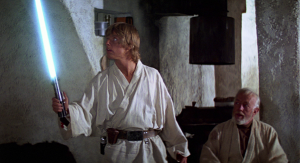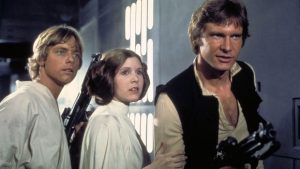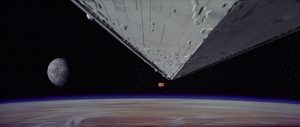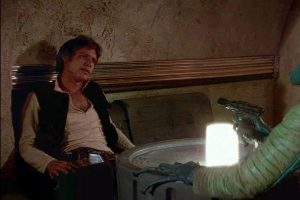We are officially in the last leg of the long journey to Star Wars: The Rise Of Skywalker, which means that the mighty Skywalker Saga, a story spanning forty years across films, books, comics, cartoons and video games is finally coming to a close – which in turn means that it’s time to reflect on that nine-part saga and take a good long look at the films that predate and inform Rise Of Skywalker‘s epic conclusion.
To do that, we’re going to have to discuss spoilers for each of the eight films in the Saga, so…SPOILERS AHEAD.
(Before we begin, be aware that I’m going through the list by order of release date: I understand that George Lucas wanted movies 4, 5 and 6 to be movies 1, 2 and 3 and to be treated as such – but they’re not good enough to warrant that distinction. Sorry, George).
Star Wars: The Empire Strikes Back
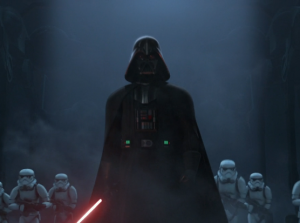
In Star Wars, the successor is always stronger than the predecessor: this is symbolized in both the Sith and the Jedi religions, where the apprentice always overcomes the master eventually, whether by force or fate – and it is symbolized in the film trilogies themselves, where each successive sequel is better than its precursor. And if A New Hope is the wise old Jedi master of Star Wars, then Empire is their fiery, free-spirited student (and that puts Last Jedi somewhere on an Anakin Skywalker level of chaotic energy).
A New Hope played by the rules, establishing a handful of lead characters, giving them a couple of fun, exhilarating obstacles to overcome, and then leaving them (and us, the audience) with a happy, satisfied feeling as we watched our plucky band of heroes rewarded with the highest honors. The Death Star had been destroyed, the terrible Darth Vader had been sent careening off into the depths of space, and Luke Skywalker (Mark Hamill) was, um, well, he was a Jedi or something, right?
Wrong. When Empire opens, it immediately establishes that the story is far from over, as the Rebellion finds themselves back on the battlefield, with Imperial forces surrounding them on all sides, hunting relentlessly for the man named Skywalker. Darth Vader (voiced by James Earl Jones) is back, with a terrifying new overlord vaguely referred to as the Emperor, and worst of all, Luke himself is caught in a hurricane of new emotions as he struggles between his desire to fulfill his Jedi training and his instinctive need to confront the power of the Darkness. Yes, while he might have been a beacon of hope and moral purity in A New Hope, Empire finds Luke wavering between good and evil, just as his father before him.
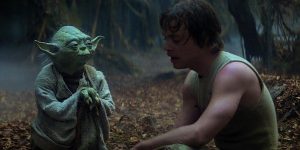
That balancing act makes Empire a thoroughly satisfying movie from a thematic point of view, and gives Hamill and the character of Luke Skywalker plenty of fascinating material to work with – watching Luke confront reality and slowly begin to understand that his youthful dream to follow in his noble father’s footsteps will in fact lead him to the Dark Side is utterly thrilling: and the movie ends just when it needs to, with Darth Vader finally breaking the young Skywalker’s steadfast resolve and destroying all of his last, desperate delusions – forcing the audience, along with Luke, to see that the concept of “destiny” can be a curse as well as a blessing. I say again, this movie is thrilling.
In many ways, Empire is the precursor to the premise of The Last Jedi – it takes the established Star Wars canon, takes one look at it, and tosses it over its shoulder. But whereas the new trilogy has been plagued by a mess of many conflicting directorial visions and an unwillingness to follow through with Last Jedi‘s promise, George Lucas’ original trilogy wasn’t afraid to “go there”. It broke the sheen of romanticism that it had built around itself, took risks, and changed the direction of the franchise – for the better. But since it was only the second movie in the entire series, fans were willing to “forgive” all of that: eight movies in…not so much.
And it’s not like Empire just made the series a little darker and more mature. It did a lot – from introducing the series’ first black character in roguish, charming heartthrob Lando Calrissian (Billy Dee Williams), to retconning one of the first film’s central plot points and making Darth Vader Luke’s father without any explanation (nowadays, Fantastic Beasts fans complain about having to wait a year or two to find out how Credence is a Dumbledore: original Star Wars fans had to wait about two decades to get answers – no wonder they’re embittered!).
In The Empires Strikes Back, the Star Wars story also moves away from the science-fiction serials and TV shows it had been based on, by taking what could very easily have been an episodic story and turning it into…a story that is definitely not episodic, but still insists on categorizing itself into episodes anyway, even forty years later. Empire builds the foundations of what would become the Skywalker Saga, by giving Luke a personal stake in the story and pitting him against a worthy enemy in Darth Vader.
Duality. Remember that from my A New Hope review? Empire expands upon the concept by throwing in the big shocker that Darth Vader is Luke’s biological father, his mirror image on the Dark Side of the Force, and supposedly the destiny that awaits him too. Vader and Skywalker orbit each other in Empire, waiting for their inevitable moment of eclipse when one will destroy the other. They are two inextricably linked forces of nature, and the greatest champions that the Force can conjure (though, there’s been a lot of theorizing recently that The Mandalorian‘s Baby Yoda, born in roughly the same year as Anakin Skywalker, might actually have been Vader’s true equal and nemesis: a bit late for that reveal, I think, but interesting nonetheless).
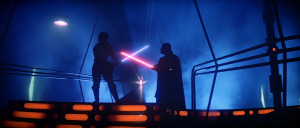
The theme of duality is also seen in the characters of Princess Leia (Carrie Fisher) and Han Solo (Harrison Ford) who have a tumultuous and similarly circuitous trajectory toward becoming the series’ defining love story. While they’ve definitely got a lot of chemistry and romantic tension as they huddle in the frozen tunnels of their Hoth base-camp, it’s only when they’re separated from Luke that things get really interesting in their relationship – not only because it prevents all the awkward accidental-incest that might have otherwise resulted, but because it gives Leia and Han a chance to solve problems on their own, without Skywalker flying in to save the day every two seconds. And it only gets more romantic when, after nearly being crushed to death in the mynock-infested mouth of a giant space-slug, Han takes Leia to safety in the Cloud City of Bespin, only to be betrayed to the Empire by his best friend, turned into a tabletop, and sold to another giant space-slug on the far side of the galaxy. Meanwhile, on a much smaller scale, C-3PO (Anthony Daniels) and R2-D2 (Kenny Baker), everyone’s favorite comedic duo, are separated and forced to survive mostly on their own – unintentionally mirroring each other’s hijinks from across the galaxy.
In Empire, we also get our first hint of Leia’s importance to the story and her mysterious connection to Luke, as she taps into the Force to see him hanging from the underbelly of Cloud City, just in time to rescue him (and yet we still pretend that Leia using the Force in The Last Jedi was a retcon). She is, of course, the infamous “another” that Yoda (voiced by Frank Oz) spoke of – the Skywalker who would outlive and outlast Luke, and maybe – just maybe – save the entire universe in its darkest hour. Since Empire, that has been Leia’s established destiny: her character arc, from those first few moments of force-sensitivity, has been leading her to a confrontation with the Dark Side, just like her brother. It’s no secret anymore that, if Carrie Fisher had not tragically passed away in 2016, she would probably have been revealed to be a Jedi in The Rise Of Skywalker, getting her very own lightsaber and wielding the Force. Depending on how much footage director J.J. Abrams was able to use of her in this film, she still might do some of that – but it’s hard to believe that we’ll see a conclusion to her story that doesn’t disappoint, considering what could have been.
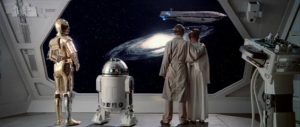
Well, that’s depressing. So…um…space battles, anyone?
Empire features some of the franchise’s most impressive action sequences, from the siege of Hoth (featuring one of my favorite Star Wars droids, the Viper probe) to the incredible, gravity-defying lightsaber duel between Darth Vader and Luke Skywalker in the Cloud City engine rooms, where words cut just as deep as weapons. It also introduced the world to bounty hunters like Boba Fett, who was so epic, he actually made a deal with Darth Vader to have Han Solo turned into a carbonite table and shipped to Jabba the Hutt in a flying iron, before being pushed into a Sarlacc pit on Tatooine and eaten…okay, forgive me for asking, but why did we all collectively decide to idolize Boba Fett? We’ve all been wondering why The Mandalorian is a pretty boring character, but has it occurred to anyone that they were never all that interesting? If I’m being honest, I was always more intrigued by that weird insectoid bounty hunter who showed up in one scene – who apparently was named Zuckuss? Yeah, I cared more about a bug-man named Zuckuss than I ever did about Boba Fett. Or his flying iron. Is no one going to explain why his spaceship was designed to look like an iron?
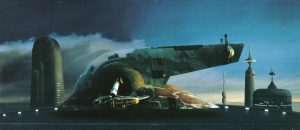
Boba Fett’s iron isn’t the only weird thing about Empire, a movie that also features: Luke being abducted by a yeti and shoved into the stomach of a space kangaroo; Muppets from space twenty years before Muppets From Space; and Darth Vader’s bizarrely well-choreographed surprise dinner party. But I’m willing to suspend my disbelief long enough to enjoy this deliciously unpredictable morsel of a movie – one that makes you want to wash it down with a tall glass of Last Jedi; the only other movie in the Star Wars…(frantically searches for a word describing a group of nine)…nonad that mixes wonderment, drama and originality so perfectly.
Movie Rating: 9/10
